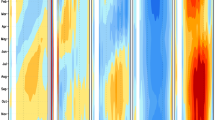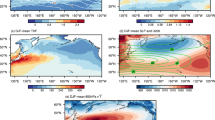Abstract
The spatiotemporal variability of equatorial Pacific upper ocean heat content (HC) and subsurface heat during two types of El Niño-Southern Oscillation (ENSO), namely eastern and central Pacific (EP and CP) types, is investigated using subsurface ocean heat budget analysis. Results show that HC tendencies during both types of ENSO are mainly controlled by oceanic heat advection beneath the mixed layer to the thermocline, and the role of net surface heat flux can be neglected. The most important three terms are the zonal and vertical advections of anomalous heat by climatological currents (QU 0 T′, QW 0 T′) and zonal advection of climatological heat by anomalous current (QU′T 0). The large contribution of QU 0 T′ extends from west to east along the equatorial Pacific. The considerable contribution of QU′T 0 is confined to the east of 160°W, and that of the QW 0 T′ is observed in the central Pacific between 180°E and 120°W. In particular, a major contribution of QW 0 T′ is also observed in the far eastern Pacific east of 100°W during EP ENSO. There is also a small contribution from meridional advection of climatological heat by anomalous current (QV′T 0). In contrast, the meridional advection of anomalous heat by climatological currents (QV 0 T′) and vertical advection of climatological heat by anomalous current (QW′T 0) are two damping factors in the HC tendency, with the former dominating. Differences in spatial distribution of the heat advection associated with the two types of ENSO are also presented. We define a warm water heat index (WWH) as integrated heat content above 26 kg m−3 potential density (26σ ɵ ) isopycnal depth within 130°E–80°W and 5°S–5°N. Further examination suggests that the recharge–discharge of WWH is involved in both types of El Niño, though with some differences. First, it takes about 42 (55) months for the evolution of a recharge–discharge cycle during an EP (CP) ENSO. Second, the EP El Niño event peaks during the discharge phase, 7–8 months after the recharge time. The CP El Niño peaks during the recharge phase, 4–5 months before the recharge time. The locations of HC anomalies in the El Niño mature phase relative to those at recharged time explain why the EP and CP El Niño peak in different stages of the recharge–discharge process.
















Similar content being viewed by others
References
Afzaal M, Li JP, Jin FF (2013) The asymmetric influence of the two types of El Niño and La Niña on summer rainfall over Southeast China. J Climate 26:4567–4582
Ashok K, Behera SK, Rao SA, Weng HY (2007) El Niño Modoki and its possible teleconnection. J Geophys Res 112:C11007. https://doi.org/10.1029/2006JC003798
Burgers G, Stephenson DB (1999) The ‘‘normality’’ of El Niño. Geophys Res Lett 26:1027–1030
Cai WJ, Rensch PV, Cowan T, Sullivan A (2010) Asymmetry in ENSO teleconnection with regional rainfall, its multidecadal variability, and impact. J Climate 23:4944–4955
Chen G (2011) How does shifting Pacific Ocean warming modulate on tropical cyclone frequency over the South China Sea? J Climate 24:4695–4700
Chung PH, Li T (2013) Interdecadal relationship between the mean state and El Niño types. J Climate 26:361–379
Clarke AJ, Van GS, Colantuono G (2007) Wind stress curl and ENSO discharge/recharge in the equatorial Pacific. J Phys Oceanogr 37(4):1077–1091
Dewitte B, Choi J, An SI, Thual S (2012) Vertical structure variability and equatorial waves during central Pacific and eastern Pacific El Niño in a coupled general circulation model. Clim Dyn 38(1112):2275–2289
Feng J, Li JP (2011) Influence of El Niño Modoki on spring rainfall over South China. J Geophys Res 116:D13102. https://doi.org/10.1029/2010JD015160
Feng J, Li JP (2013) Contrasting impacts of two types of ENSO on the boreal spring Hadley circulation. J Climate 26:4773–4789
Fu CB, Fletcher J (1985) Two patterns of equatorial warming associated with El Niño. Chin Sci Bull 30(10):1360–1364
Hoerling M, Kumar A, Zhong M (1997) El Niño, La Niña, and the nonlinearity of their teleconnections. J Clim 10:1769–1786
Hu ZZ, Kumar A, Bhaskar J, Wang WQ, Huang BH, Huang BY (2012) An analysis of warm pool and cold tongue El Niños: air-sea coupling processes, global influences, and recent trends. Clim Dyn 38(9–10):2017–2035
Jin FF (1997a) An equatorial ocean recharge paradigm for ENSO. Part I: conceptual model. J Atmos Sci 54:811–829
Jin FF (1997b) An equatorial ocean recharge paradigm for ENSO. Part II: a stripped-down coupled model. J Atmos Sci 54:830–847
Jin FF, An SI, Timmermann A, Zhao J (2003) Strong El Niño events and nonlinear dynamical heating. Geophys Res Lett 30:1120. https://doi.org/10.1029/2002GL016356
Kao HY, Yu JY (2009) Contrasting eastern-Pacific and central-Pacific types of ENSO. J Clim 22:615–632
Kim HM, Webster PJ, Curry JA (2009) Impact of shifting patterns of Pacific Ocean warming on North Atlantic tropical cyclones. Science 325:77–80
Kug JS, Jin FF, An SI (2009) Two types of El Niño events: cold tongue El Niño and warm pool El Niño. J Clim 22:1499–1515
Kug JS, Choi J, An SI, Jin FF, Wittenberg AT (2010) Warm pool and cold tongue El Niño events as simulated by the GFDL 2.1 coupled GCM. J Clim 23:1226–1239
Larkin NK, Harrison DE (2005a) On the definition of El Niño and associated seasonal average U. S. weather anomalies. Geophys Res Lett 32:L13705. https://doi.org/10.1029/2005GL022738
Larkin NK, Harrison DE (2005b) Global seasonal temperature and precipitation anomalies during El Niño autumn and winter. Geophys Res Lett 32:L16705. https://doi.org/10.1029/2005GL022860
Lee T, McPhaden MJ (2010) Increasing intensity of El Niño in the central-equatorial Pacific. Geophys Res Lett 37:L14603. https://doi.org/10.1029/2010GL044007
Lu Q, Ruan ZX, Wang DP, Chen DK, Wu QY (2017) Zonal transport from the western boundary and its role in warm water volume changes during ENSO. J Phys Oceanogr 47(1):211–225. https://doi.org/10.1175/JPO-D-16-0112.1
Ma T, Yu JY (2014) Linking centennial surface warming patterns in the equatorial Pacific to the relative strengths of the Walker and Hadley circulations. J Atmos Sci 71:3454–3464
McPhaden MJ (2008) Evolution of the 2006–07 El Niño: the role of intraseasonal to interannual time scale dynamics. Adv Geosci 14:219–230
McPhaden MJ (2012) A 21st century shift in the relationship between ENSO SST and warm water volume anomalies. Geophys Res Lett 39:L09706. https://doi.org/10.1029/2012GL051826
McPhaden MJ, Zhang X (2009) Asymmetry in zonal phase propagation of ENSO sea surface temperature anomalies. Geophys Res Lett 36:L13703. https://doi.org/10.1029/2009GL038774
Meinen CS, McPhaden MJ (2000) Observations of warm water volume changes in the equatorial Pacific and their relationship to El Niño and La Niña. J Clim 13:3551–3559
North GR, Bell TL, Cahalan RF, Moeng FJ (1982) Sampling errors in the estimation of empirical orthogonal functions. Mon Wea Rev 110:699–706
Okumura YM, Deser C (2010) Asymmetry in the Duration of El Niño and La Niña. J Clim 23(21):5826–5843
Overland JE, Preisendorfer RW (1982) A significance test for principal components applied to a cyclone climatology. Mon Wea Rev 110:1–4
Ramesh N, Murtugudde R (2013) All flavours of El Niño have similar early subsurface origins. Nat Clim Change 3:42–46
Rayner NA, Parker DE, Horton EB, Folland CK, Alexander LV, Rowell DP, Kent EC, Kaplan A (2003) Global analyses of sea surface temperature, sea ice, and night marine air temperature since the late nineteenth century. J Geophys Res 108(D14):4407. https://doi.org/10.1029/2002JD002670
Ren HL, Jin FF (2011) Niño indices for two types of ENSO. Geophys Res Lett 38:L04704. https://doi.org/10.1029/2010GL046031
Ren HL, Jin FF (2013) Recharge oscillator mechanisms in two types of ENSO. J Clim 26(17):6506–6523. https://doi.org/10.1175/JCLI-D-12-00601.1
Singh A, Delcroix T (2013) Eastern and central Pacific ENSO and their relationships to the recharge/discharge oscillator paradigm. Deep-Sea Res I 82:32–43. https://doi.org/10.1016/j.dsr.2013.08.002
Takahashi K, Montecinos A, Goubanova K, Dewitte B (2011) ENSO regimes: reinterpreting the canonical and Modoki El Niño. Geophys Res Lett 38:L10704. https://doi.org/10.1029/2011GL047364
Trenberth K, Stepaniak DP (2001) Indices of El Niño evolution. J Clim 14:1697–1701
Wang C, Weisberg RH (2000) The 1997-98 El Niño evolution relative to previous El Niño events. J Clim 13:488–501
Weng HY, Ashok K, Behera SK, Rao SA, Yamagata T (2007) Impacts of recent El Niño Modoki on dry/wet conditions in the Pacific rim during boreal summer. Clim Dyn 29:123–129
Wu CR, Wang LC (2013) Contrasting the evolution between two types of El Nino in a data assimilation model. Ocean Dyn 63:577–587
Xie F, Li JP, Tian WS, Feng J, Huo Y (2012) Signals of El Niño Modoki in the tropical tropopause layer and stratosphere. Atmos Chem Phys 12:5259–5273
Xie F, Li JP, Tian WS, Zhang JK, Sun C (2014) The relative impacts of El Niño Modoki, canonical El Niño, and QBO on tropical ozone changes since the 1980s. Environ Res Lett. https://doi.org/10.1088/1748-9326/9/6/064020
Yang CY, Ren BH, Li G, Zheng JQ (2014) Change of the wintertime SSTA variability over the West Pacific after the mid-1980s: effect of the increasing El Niño Modoki. J Geophys Res Atmos 19(9):5204–5225
Yu JY, Kao HY (2007) Decadal changes of ENSO persistence barrier in SST and ocean heat content indices: 1958–2001. J Geophys Res 112:D13106. https://doi.org/10.1029/2006JD007654
Yu JY, Kim ST (2011) Relationships between extratropical sea level pressure variations and the central Pacific and eastern Pacific types of ENSO. J Clim 24(3):708–720
Yu JY, Zou Y (2013) The enhanced drying effect of Central-Pacific El Niño on US winter. Environ Res Lett. https://doi.org/10.1088/1748-9326/8/1/014019
Yu JY, Sun F, Kao HY (2009) Contributions of Indian Ocean and monsoon biases to the excessive biennial ENSO in CCSM3. J Clim 22:1850–1858
Yu JY, Kao HY, Lee T (2010) Subtropics-related interannual sea surface temperature variability in the equatorial central Pacific. J Clim 23:2869–2884
Yu JY, Kao PK, Paek H, Hsu HH, Hung CW, Lu MM, An SI (2015) Linking emergence of the central-Pacific El Niño to the atlantic multi-decadal oscillation. J Clim 28(2):651–662
Zhang T, Sun DZ, Neale R, Rasch PJ (2009) An evaluation of ENSO asymmetry in the community climate system models: a view from the subsurface. J Climate 22:5933–5961
Zhang W, Jin FF, Li J, Ren HL (2011) Contrasting impacts of two-type El Niño over the western North Pacific during boreal autumn. J Meteor Soc Jpn 89:563–569
Acknowledgements
We thank two anonymous reviewers for their constructive and valuable suggestions. This work was supported by the Natural Science Foundation of China (NSFC) (Nos. 41476017, 41330963, 41506023), NSFC-Shandong Joint Fund for Marine Science Research Centers (No. U1406401), Fund for Innovative Research Groups of the NSFC (No. 41421005), and the “Strategic Priority Research Program” of the Chinese Academy of Sciences (No. XDA01010101).
Author information
Authors and Affiliations
Corresponding author
Rights and permissions
About this article
Cite this article
Feng, J., Jin, Ff., Hu, D. et al. Oceanic processes of upper ocean heat content associated with two types of ENSO. J Oceanogr 74, 219–238 (2018). https://doi.org/10.1007/s10872-017-0452-y
Received:
Revised:
Accepted:
Published:
Issue Date:
DOI: https://doi.org/10.1007/s10872-017-0452-y




